Kathy Lynn Emerson's Blog, page 62
October 12, 2016
Male Partnering in the Birth Experience (Or, You Can’t Fire the Coach, No Matter How Big a Dufus He Is)
Since a previous post about preparing for parenthood was received well, here is another chapter from my tongue-in-cheek guide to parenting called How to Raise the Perfect Child, Or At Least Lie About It. Thanks for indulging me as I take a brief respite from the murder and mayhem of writing thrillers to luxuriate in the humor and mayhem of parenting.
Maybe I’m biased, but I think this deserves its own whole chapter.
When my cousin and his wife were taking Lamaze classes for the first time, the instructor gave the soon to be mothers an important piece of advice at the outset: you can’t fire the coach. Left unsaid was the remainder of her sentence: no matter how big a dufus he is.
Coaching is the generally accepted term for the soon to be father’s role in delivery. He’s supposed to guide his wife through the process, letting her know what’s coming, praising her and just generally being a supportive, loving and caring force for her during this difficult, yet triumphant and empowering, experience.
Right.
When I think of coaching, I think of Vince Lombardi prowling the sidelines at frozen Lambeau Field. A master tactician. Making all the right moves. In control of everything. Marching the Packers on to victory. That certainly wasn’t my role in the birthing process.
I wasn’t the coach. I wasn’t even the assistant coach. I was the coach’s sister’s idiot son, sitting on the end of the bench. A senior who never had and never would see a minute of playing time and whose biggest athletic attribute was the ability to separate the home from away uniforms. I wasn’t in control of anything. At best, every now and then, I could contribute a feeble “Go team” from the sidelines.
When my wife and I were in Lamaze for the first time, our instructor showed us a video of what the husband should do in the delivery room. Maybe you’ve seen this video. There is a lovely red-haired woman sitting in a rocking chair, slowly rocking back and forth. She’s enraptured. She smiles constantly. In fact, she smiles through the entire delivery. I thought it was a commercial for Crest. Either that or she was an Osmond.
Now, the only inkling you get that she is, in fact, in labor is that every once in a great while she sucks in a small amount of air and then lets it out slowly. This woman goes through the entire labor without once swearing, crying or even mussing her hair. She spends most of it cross-stitching. Now I won’t say that my wife feels that that woman misled her about childbirth, but if you hold your screen close to your ear, you can still hear her swearing. Just keep this away from the kids.
Perfect, unruffled woman was not alone, however. By her side was perfect, supportive man. Her husband knew precisely what to say and when to say it. He knew when to remain quiet. He was calm and reassuring. And I’m pretty sure he was reading from a script, because I certainly don’t know any guy that facile. Most of us are like the second guy in the video: the just shut up guy. This guy couldn’t do anything right. The entire delivery was one long monotone: you’redoingfineyou’redoingfineyou’redoingfine. All the women in our class cheered when, after the delivery was finished, his wife looked at the camera and said: “I wanted to tell him to just shut up.” All the men in our class glanced apprehensively at each other. We knew. We were going to be the just shut up guy.
Some of my friends made the just shut up guy look good. One friend, seeing his wife in greater pain than ever before in her life, decided the moment needed a little levity. He broke in a new stand-up routine. As she writhed in pain, trying to bring his first child into the world, he did his best Jerry Seinfeld impersonation. For their second child, this friend abandoned stand-up for a career in sports broadcasting. He did play-by-play on the telephone to his parents for the entire delivery. “And the doctor hands the baby to the nurse. It’s an end-around. Oh no! Fumble!” His stitches will come out soon.
Another friend had it even worse. Now, most guys picture themselves Rambo-tough. The kind of guy who would never become squeamish at the sight of blood or anything, to use the scientific term, gooky. And this friend is a pretty tough guy. Unfortunately, not on this day. As he’s standing next to his wife, holding her hand, trying to be supportive, suddenly the room starts to get a little wavy. Being a tough guy, he doesn’t want to say anything, but that room keeps getting wavier. He lets go of his wife’s hand, who by the way is being of no assistance to him, and wipes his forehead when suddenly the instrument tray lunges against him and crashes to the floor, scattering the instruments around the room. Then the monitor smacks into him. Just trying to be polite and get out of the way, he backs into the wall and triggers some alarm. Seeing no graceful way out, he faints dead away. He wakes up on a gurney in the delivery room next to his wife’s gurney. His stitches come out soon, as well.
Another one of our friends took the complete opposite tact from the fainter. He LOVED the delivery. Not five minutes after his wife, battling dangerously high blood pressure, delivered his first child at great personal risk, our friend turned to his wife and, with a smile on his lips and love in his heart, proclaimed: “THIS WAS GREAT! LET’S DO IT AGAIN!” I don’t think his stitches will ever come out.
Now I was sure that I was ready for a starring role as coach. I had read how to be a good coach. The book said to bring a tennis ball to massage my wife’s back, so I did. The book said to bring a book to read to distract her from the pain, so I did. None of these ever left the overnight bag.
Instead, with our son, Morgan, my job was to watch the pain monitor. Unsure what the appropriate term for this was, I called it the “Holy Mother” box. As in “Holy Mother of God, a big one’s coming!” The nurse turned the monitor away from Erica and explained that the thin line tracking across the screen would show the strength of the contraction she was having, the one she just had, and the one coming. That placed me in a bit of a moral dilemma. I felt like Keith Jackson on the Weather Channel during tornado season: You think that one was bad, wait until you get a load of the next one coming. Whoa Nelly!
I struck a compromise with myself. I would tell her about every third contraction. The others I would swear the machine didn’t show. It led to priceless conversations like:
My wife: Arggghhhhhh! Is it almost over?
Me: (glancing nervously at the pain monitor): Ah, yes?
My wife: Seriously. Just tell me. Is it almost over?
Me: (a little more definite now) Yes.
My wife: Are you lying?
Me: (turning machine farther away from her) Absolutely not.
My wife: (next wave hits) ARGGH! BASTARD!
With our first daughter (second child), I was demoted. I was still on the sidelines, but I was primarily the student trainer who walks the injured athlete back and forth. That was my job. Walk my wife up one hallway, then down the second. Then back to the first. Then, oh heck, let’s see that second one again. For approximately six hours, my wife and I walked up and down these two hallways. After the first hour, I stopped asking her how she felt every two minutes and concentrated on not being the Just Shut Up Guy.
Then, suddenly, the Head Coach decided it was time my wife joined the game. Within twenty minutes, my wife shot from four centimeters to full dilation. We raced for the delivery room. More accurately, my wife proceeded at full waddle while I buzzed around her like some hopped-up mosquito. The nurse told Erica that the doctor hadn’t expected her to progress so rapidly, but would be in our room in “two minutes.” In her best Clint Eastwood impression, Erica informed the nurse that the doctor’s two minutes were up. At that point, I hid under the gurney.
When the doctor arrived, I figured it might be safe to crawl out from under the gurney, because, at that particular moment, my wife hated him even more than me. Just the sound of his voice ticked her off. “Push?” I offered meekly. “I can’t, it hurts,” she panted. “Erica…” the doctor began. “YAAARGHHHH!” she responded. Two pushes later, our daughter shot into this world. It’s a good thing the doctor had his catcher’s mitt on, or Shannon would have ricocheted around that room like a pinball.
I congratulated everyone on playing a good game, but, I have to admit, I had a few misgivings. While I was no longer the Just Shut Up Guy, I had become the Were You in the Room Guy. I’m not sure that’s a good thing.
Things didn’t improve with the birth of our second daughter, Maura (third child, for those of you still counting). I wasn’t even the student trainer any longer. I was the star athlete’s groupie friend, hanging out in the hot tub and trying to score drugs for the star from anyone and everyone. Erica’s mother took her up and down the hallways to “walk it off” while I played with the buttons on the hospital bed. They gave my “Holy Mother” monitor to a nurse; like she would know what to do with it. Basically, I spent the game parked in Row ZZZ.
I guess I shouldn’t have been surprised. By the third time, Erica was no longer a rookie. She knew what she was doing, and didn’t need the coach. It’s just the state of the game these days. No one listens to their coaches anymore.
Given recent history though, that might not be a bad thing.
Push?
October 11, 2016
If My Writing Life Had A Playlist
Kate Flora: Some years ago, while I was working on a book, I decided that I needed to  create a playlist to listen to that would help me get into the mind of my central character. It was a long time ago. If I actually made that playlist, I’ve long since lost it into the innards of a now-extinct iPod, a former computer, or the cobwebby vastness of my brain. All I remember is sending out an e-mail call for help to the young women in my family asking about what they listened to when they were angry. Then, when I was working on Finding Amy, and living every day with the tragedy of her death, I learned that Dante’s Prayer, by Loreena McKennitt, was one of her favorite songs. I listened to it then, and I listen to it now, and remember the lovely young woman I never knew. https://www.youtube.com/watch?v=FDw3CyOmj20
create a playlist to listen to that would help me get into the mind of my central character. It was a long time ago. If I actually made that playlist, I’ve long since lost it into the innards of a now-extinct iPod, a former computer, or the cobwebby vastness of my brain. All I remember is sending out an e-mail call for help to the young women in my family asking about what they listened to when they were angry. Then, when I was working on Finding Amy, and living every day with the tragedy of her death, I learned that Dante’s Prayer, by Loreena McKennitt, was one of her favorite songs. I listened to it then, and I listen to it now, and remember the lovely young woman I never knew. https://www.youtube.com/watch?v=FDw3CyOmj20
As you know, from reading this blog, listening to writers, or from your own writer’s life, the journey from idea to publication can be a long and sometimes painful one. I have some “anthems” that I play when I’m angry and frustrated about how hard it is, even with a track record of good books, to get published and stay published, among which is Freddy Mercury and Queen’s, “I Want It All.” https://www.youtube.com/watch?v=hFDcoX7s6rE
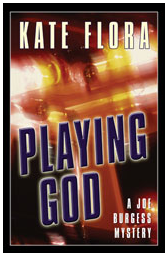
The Joe Burgess series begins with Playing God
A long, strange journey has certainly been the case with my newest book, Led Astray. First of all, I wasn’t planning to write another Joe Burgess book. When I envisioned the series, my plan was to write a quartet spanning the four seasons. The series began on an icy February night in Portland, when Burgess is called to the scene of a doctor murdered in his Mercedes, in Playing God. That was followed by the steamy heat of summer, and a dead child in a city park, in The Angel of Knowlton Park. Redemption, the story of a Vietnam veteran who came back damaged and never quite got it together, takes place during a glorious Maine October. The series was going to end with spring, and Burgess’s hopes for a more normal life, in And Grant You Peace, as Burgess tries to balance caring for his family with investigating a complicated crime among Portland’s Somali immigrant community.
If Joe Burgess, a lapsed Catholic, with a strong moral compass and deep compassion for  people who can’t defend themselves, has a playlist, it’s going to veer between the music he listened to in Vietnam, and the hymns I listen to while I getting in touch with who he is. Like this: https://www.youtube.com/watch?v=SV7znC9TWYs or this: https://www.youtube.com/watch?v=TLV4_xaYynY And Joe Burgess, being an Irish-American cop, loves this song, which I play for him from time to time: Mary Black, Song for Ireland https://www.youtube.com/watch?v=sbRuLOfHYfw
people who can’t defend themselves, has a playlist, it’s going to veer between the music he listened to in Vietnam, and the hymns I listen to while I getting in touch with who he is. Like this: https://www.youtube.com/watch?v=SV7znC9TWYs or this: https://www.youtube.com/watch?v=TLV4_xaYynY And Joe Burgess, being an Irish-American cop, loves this song, which I play for him from time to time: Mary Black, Song for Ireland https://www.youtube.com/watch?v=sbRuLOfHYfw
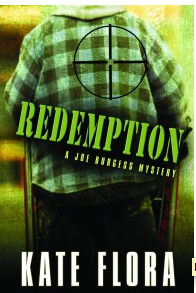 After the publication of And Grant You Peace, people started asking when they could read the next Burgess. I said I’d done the four seasons and I was done. And people reminded me that Maine has more than four seasons. For starters, there’s hunting season, mud season, blackfly season, and tourist season. So I e-mailed the publisher and asked if they’d like another Burgess, and stuck myself in a chair and wrote what my husband calls the 5th book in a 4 book series. The working title was: And Led Them Thus Astray. I met my deadline, delivered the book, got roundly and soundly beaten up by my editor, and after revisions was told the book was in the queue for a contract, and would be published in the fall of 2016.
After the publication of And Grant You Peace, people started asking when they could read the next Burgess. I said I’d done the four seasons and I was done. And people reminded me that Maine has more than four seasons. For starters, there’s hunting season, mud season, blackfly season, and tourist season. So I e-mailed the publisher and asked if they’d like another Burgess, and stuck myself in a chair and wrote what my husband calls the 5th book in a 4 book series. The working title was: And Led Them Thus Astray. I met my deadline, delivered the book, got roundly and soundly beaten up by my editor, and after revisions was told the book was in the queue for a contract, and would be published in the fall of 2016.
Months passed. No contract appeared. No virgin in the publishing industry, I saw the 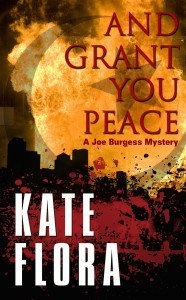 writing on the wall, and sure enough, in January, instead of a contract I got the news that the publisher was discontinuing their mystery line. Poor Joe Burgess was an orphan. I consoled myself with endless repetitions of Leonard Cohen’s Hallelujah, which is truly music one can get lost in, https://www.youtube.com/watch?v=YrLk4vdY28Q as I pondered whether to look for another publisher.
writing on the wall, and sure enough, in January, instead of a contract I got the news that the publisher was discontinuing their mystery line. Poor Joe Burgess was an orphan. I consoled myself with endless repetitions of Leonard Cohen’s Hallelujah, which is truly music one can get lost in, https://www.youtube.com/watch?v=YrLk4vdY28Q as I pondered whether to look for another publisher.
In the end, after playing some music a bit more upbeat–Cher’s Just Like Jesse James (dreaming of the publishing industry going down in flames) https://www.youtube.com/watch?v=KeWN4Zr10kM and Cindi Lauper’s Girls Just Wanna Have Fun, https://www.youtube.com/watch?v=PIb6AZdTr-A because I DO want to have fun with this writing adventure, I decided to take control of my own destiny, and release the 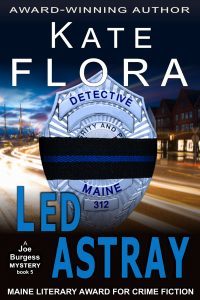 book myself. The title got shortened to Led Astray to fit on the cover, and Joe Burgess finally gets his day in the sun. The e-book comes out on the 8th, the physical book and other e-book platforms in a few weeks.
book myself. The title got shortened to Led Astray to fit on the cover, and Joe Burgess finally gets his day in the sun. The e-book comes out on the 8th, the physical book and other e-book platforms in a few weeks.
Now I wait to see what happens.
(Note: all of the books except Led Astray have new covers in their e-book and paperback form. These are the original publisher’s versions)
October 9, 2016
Danube Cruise — Tragedy and Valor
Susan Vaughan here. We made friends and enjoyed the sights on our recent Viking Cruise on the Danube River from Germany to Austria. What happened, both good and bad, keeps turning over in my mind, so I felt I needed to write about it.
The cruise did not turn out as planned, except for the excellent weather—warm, even hot, and sunny the entire week. On the first night aboard the Viking Freya, at about one thirty, I felt a huge shudder and heard splashing as the ship suddenly stopped. At three o’clock, the public address system announced the ship had had an accident and all passengers were to go to the dining room. Police and emergency responders filled the near shore and the bridge above us. We could see that in the headlights of the ambulances and fire trucks that the Freya had hit a railroad bridge.
There was much grumbling and complaining and joking about someone losing his job over this, but the grim faces around us told another story. The ship was disabled from the impact, but we had to wait until a gangplank could be set up and transportation provided. At daylight we abandoned the Freya, aided by our crew and volunteer Red Cross, over two hundred people, from Erlangen. This is not a huge town, but their support and caring were wonderful, so many people in such a short time, to help us strangers.
Later that morning everyone was booked into hotels in central Nuremberg. We didn’t learn until later more details at a meeting called by a Viking executive. He shared news that sobered everyone. Apparently the wheelhouse didn’t lower as it was supposed to for traveling below bridges. The accident smashed the wheelhouse, and the Freya captain and a crew member were killed.
Such a terrible outcome, beyond what I’d imagined or guessed. I still don’t know whether it was hydraulics failure or human error or a combination. The Viking rep offered to send anyone home who wished, but most of us remained, making the best of the situation. Viking as a company and our crew as a team seemed intent on carrying on.
The group had lunch at a Rathausplatz (Town Hall Square) restaurant, with traditional Bavarian fare that included beer and bratwurst. Afterward, Torstein Hagen, the chairman and CEO of Viking Cruises, greeted us. Having arrived to support his grieving crew, he expressed his deep regrets for the accident that marred our trip. Other Viking ships had had mishaps, but these were the first deaths.
Then, although it seemed inappropriate under the circumstances, we proceeded with our tour of Nuremberg. You may recognize the city name from the Nuremberg Trials after WWII. The trials were located there because the city had been Hitler’s headquarters. Nuremberg’s Zeppelin Field was the stadium where he staged some of his fiery speeches and paraded his troops. The stadium belongs to the town, which uses it for performances and sporting events.
Nuremberg is a sprawling modern city, but also boasts an imperial palace and a medieval section behind a fortress wall. Another ship had to be outfitted and brought to meet us, so for next three days we traveled by motor coach and spent two nights in a golf resort hotel. The coach trip included our regular scheduled visits—the medieval town of Regensburg, the city of Passau on the German-Austria border, and Gottweig Abbey. After the visit to that 900-year-old working monastery, we boarded the Viking Bestla, happy to be reunited with the Viking Freya crew.
 Our cruise concluded with two days in Vienna, home to the Hapsburg dynasty, rulers of the Holy Roman Empire for generations. Also the city of many famous artists and composers, Vienna juxtaposes contemporary life and imperial majesty. The fabulous facades of ancient palaces must be maintained by law, but inside many are modern offices or apartments.
Our cruise concluded with two days in Vienna, home to the Hapsburg dynasty, rulers of the Holy Roman Empire for generations. Also the city of many famous artists and composers, Vienna juxtaposes contemporary life and imperial majesty. The fabulous facades of ancient palaces must be maintained by law, but inside many are modern offices or apartments.
We missed some tours and cruising, but overall, we enjoyed the trip and made new friends, bonded by this shared experience.
For me, the deaths were shocking and sad but not personal, partly because neither man was introduced to the passengers. On our Rhine cruise two years ago and when we boarded the Bestla, the captains welcomed everyone at the first evening’s briefing. I wonder still if the mechanical issue that led to the Freya’s accident had kept the captain from joining us that night.
I cannot end without stressing that Viking as a company and the Freya crew were outstanding in their handling of the situation. And before you ask, yes, we’ll do another Viking cruise, where TBD. If you would like to see more of this cruise, you can find pictures and a day-by-day log on Facebook (Susan H. Vaughan).
October 7, 2016
Weekend Update: October 8-9, 2016
 Next week at Maine Crime Writers there will be posts by Susan Vaughan (Monday), Brendan Rielly (Tuesday), Kate Flora (Wednesday), John Clark (Thursday), and Kaitlyn Dunnett/Kathy Lynn Emerson (Friday).
Next week at Maine Crime Writers there will be posts by Susan Vaughan (Monday), Brendan Rielly (Tuesday), Kate Flora (Wednesday), John Clark (Thursday), and Kaitlyn Dunnett/Kathy Lynn Emerson (Friday).
In the news department, here’s what’s happening with some of us who blog regularly at Maine Crime Writers:
from Kaitlyn Dunnett: I’ve got a Goodreads giveaway for the paperback of The Scottie Barked at Midnight going on now. It’s open until October 20. Here’s the link:
https://www.goodreads.com/giveaway/show/205951-the-scottie-barked-at-midnight
From Kate Flora: It’s finally here–after a long and tortuous journey (more about this in my blog post later this week)–the 5th Joe Burgess police procedural, Led Astray. Here’s the synopsis:
 A police officer’s worst nightmare is realized when Detective Joe Burgess, called to an abandoned warehouse, finds one officer shot and two others gravely wounded. Someone is targeting Portland’s cops, including his lieutenant. As Lt. Vince Melia lies near death in a local hospital, it becomes Burgess’s task to sift through Melia’s past cases for someone with an anger so strong he has targeted an entire police department for revenge. Portland’s cops go through their days feeling like they’re wearing targets on their backs, as Burgess and his team race against time. They have to find the shooter before Rookie Randall Crossman’s funeral—a day when the city will fill with officers paying their last respects—and the perfect time for the shooter to carry out a spectacular revenge.
A police officer’s worst nightmare is realized when Detective Joe Burgess, called to an abandoned warehouse, finds one officer shot and two others gravely wounded. Someone is targeting Portland’s cops, including his lieutenant. As Lt. Vince Melia lies near death in a local hospital, it becomes Burgess’s task to sift through Melia’s past cases for someone with an anger so strong he has targeted an entire police department for revenge. Portland’s cops go through their days feeling like they’re wearing targets on their backs, as Burgess and his team race against time. They have to find the shooter before Rookie Randall Crossman’s funeral—a day when the city will fill with officers paying their last respects—and the perfect time for the shooter to carry out a spectacular revenge.
Right now, it’s only on Amazon, but the print version and e-books on other platforms are coming soon. https://www.amazon.com/Led-Astray-Burgess-Mystery-Book-ebook/dp/B01LXRC3G9/ref=sr_1_6?ie=UTF8&qid=1475846989&sr=8-6&keywords=led+astray+kindle
Last weekend, many of us gathered in Bar Harbor for a crime writing weekend hosted by the Jesup Memorial Library. Here are some candid shots from that event:
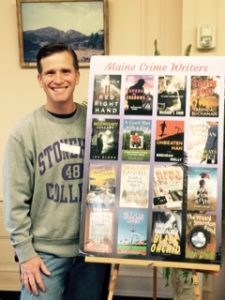
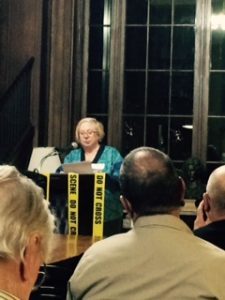
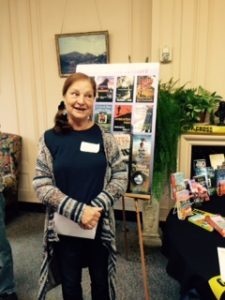

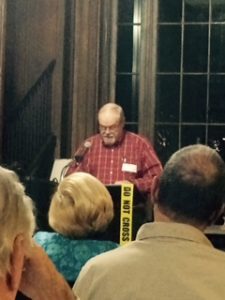
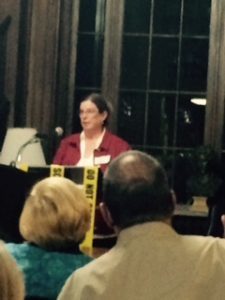
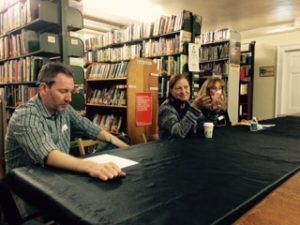
And on Wednesday, Bruce Coffin celebrated the publication of his first police procedural, Among the Shadows, with beer, bagpipes, and approximately a thousand close friends.
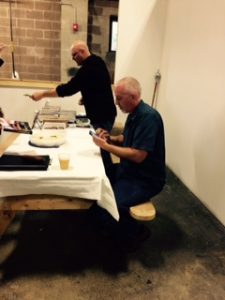

From Vaughn C. Hardacker: On Wednesday, October 12, 2016, I will be appearing at the Windham Public Library, 217 Windham Center Road, Windham, ME  04062 from 6:00 p.m. to 7:30 p.m. On Saturday, October 15, 2016, I will be appearing at the Barnes & Noble Booksellers, 9 Marketplace Drive, Augusta, Maine 04330 from 11:00 a.m. until 1:00 p.m.
04062 from 6:00 p.m. to 7:30 p.m. On Saturday, October 15, 2016, I will be appearing at the Barnes & Noble Booksellers, 9 Marketplace Drive, Augusta, Maine 04330 from 11:00 a.m. until 1:00 p.m.
An invitation to readers of this blog: Do you have news relating to Maine, Crime, or Writing? We’d love to hear from you. Just comment below to share.
And a reminder: If your library, school, or organization is looking for a speaker, we are often available to talk about the writing process, research, where we get our ideas, and other mysteries of the business. Contact Kate Flora
October 6, 2016
Maggie and Me: Same or Different?
There’s a game children play with either pictures or words: which things are the same? Which are different? (Table. Dog. Mouse. Cheese. Which is different?) More advanced versions appear on SAT tests. My kids and I sometimes played that game at the dinner table. (Yes: I was that kind of mom.) 
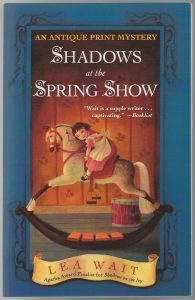
Authors play the game, too, but with characters. Is the father in the book like HER father? Did HIS brother really beat him up as a kid? Did SHE ever live in Iceland, like her character?
Because I’ve now written eight books about protagonist Maggie Summer, and because, yes, there are some similarities in our lives (confession: first books are often like that, and SHADOWS AT THE FAIR, the first in this series, was also the first full book I wrote.) I’m often asked, simply, “Are you Maggie?”
I always say, 
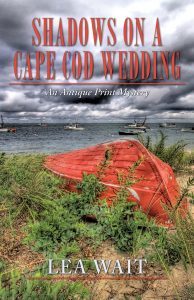
No! She’s younger and braver than I am.”
And yet — Maggie and I have a lot in common, too.
So here’s the scoop: the truth about Maggie and me.
Maggie has an older brother. I have two younger sisters.
Maggie grew up in Summit, New Jersey, and graduated from Montclair State. She has a doctorate in American Studies. I grew up in Maine and Glen Ridge, New Jersey, and graduated from Chatham College in Pittsburgh and have a doctorate without dissertation from New York University — in American Studies. 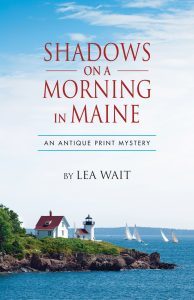

Maggie teaches at a community college in New Jersey. I’ve never taught more than a workshop, but I did work for a corporation in New Jersey. We both lived in Somerset County.
Maggie is five feet six inches tall and has long brown hair. I’m five feet two and, most of my life, had long blonde hair. (Bonus information: I just cut it.)
Maggie owns and operates an antique print business called “Shadows.” For about thirty years I had an antique print business, too: “MAH Antiques.” Now I write full-time.
Maggie was widowed when she was 37. (The Shadows series begins when she’s 38.) I’ve 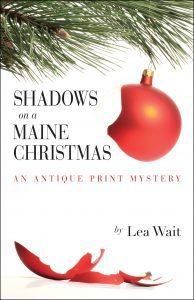 never been widowed, but I was divorced in my twenties.
never been widowed, but I was divorced in my twenties.
Maggie has a cat, Winslow Homer. I (now) have a cat, Shadow. (I didn’t have a cat when I started the series … but there are all kinds of research!)
Maggie drinks diet Pepsi and Dry Sack sherry. I don’t drink soda, but Dry Sack is my special treat. Yum!
Maggie wants to adopt an older child as a single parent. I adopted four girls, ages 5-10, as a single parent.
Maggie’s prospective daughter is from Maine. My daughters were born in Korea, Thailand, Hong Kong and India.
Maggie’s in love with a guy who doesn’t want to be a father. Yup, me too. I ended up marrying him after my daughters were grown up.
Maggie moved from New Jersey to Maine when she was forty. I became a full-time, all-season Maine resident when I moved from New Jersey at fifty-two.
Maggie can shoot. Nope, not me.
Maggie solves crimes. I only do that fictionally.
Maggie is stubborn, and hopeful about the future. I hope I am, too!
And — to find out more about Maggie (and maybe me,) check out the series! The books take place approximately three months apart, during two years. In order, they are:
Shadows at the Fair
Shadows on the Coast of Maine
Shadows on the Ivy
Shadows at the Spring Show
Shadows of a Down East Summer
Shadows on a Cape Cod Wedding
Shadows on a Maine Christmas
Shadows on a Morning in Maine
And enjoy!
October 5, 2016
Tattoos While You Wait
OK, once again, I get the ideas question, on a plane flying back from Bouchercon 2016 (a  fine time, by the way).
fine time, by the way).
You know what I’m talking about: “Where, dear writer, do you get your ideas?” I did my best to push beyond one of my standard answers (the planet Mars, too many Sazeracs, gumbo indigestion) and think about it but I was still back in the second line dancing down Canal Street and I couldn’t think of a thing. I made a vague answer and we moved onto other topics.
But after I’d eaten my .3 ounce bag of peanuts and drunk my cracked plastic glass of club soda, I realized I had a better answer than the one I’d given (which of course I’ve already forgotten). I remembered another flight this spring, flying back from the other Portland after visiting a friend in hospice, when I sat next to a wide-shouldered grizzled young fellow, taciturn, well-tatted up and down his arms. I thought at first we might not have anything interesting to talk about, but not for the first time in my life, I was completely wrong.
I threw out the standard opener: what do you do, what were you doing in Portland?
“Well, I’ve been working out in Hood River the last couple months.”
I notice the scars and burn marks, on his hands and forearms.
“Looks like it might have been a little dangerous.”
From him, I get this sly look and, though I didn’t recognize it at the time, he was already smirking about what he was going to tell me.
“Building the world’s largest tofurkey oven.”
Well, that would have sparked a different conversation right there, if either one of us had been a vegan or even vegetarian. Turns out, as you might have expected, there’s a huge demand for tofu products in the Pacific Northwest and one bright entrepreneur in the town on the Columbia River decided to take the plunge and create a tofurkey factory. The largest. In the world.
For those unfamiliar with the, uh, substance, tofurkey is a vegetarian replacement for turkey made of wheat protein and tofu.
It usually comes in rolls that look something like a turkey breast and I saw them on many Thanksgiving tables when I lived out there on the far northern corner of things. Have never tasted one, though. Do not intend to.
The world’s largest tofurkey factory, as it turns out, is delivered to its site in large stainless steel modules that must be welded together before the appropriate machinery can be installed and the tofurkey start oozing. This fellow—I got so interested in what he was telling me, I never did ask his name—was in charge of the team of welders who fastened the modules of the factory together.
None of this would have been overly interesting except that he started to get excited about the details of what he did every day—people love to talk about themselves and if you listen, you never know what kind of information you’ll pick up. He began by describing his work day, the various types of welding (MIG? TIG?), and most importantly, how to tell good welding from bad. Interesting stuff: trust me when I tell you my day-to-day doesn’t include a lot of contact with welders.
But what perked my ear up was when he talked about the way one welder judges whether another one knows what he’s doing. It’s a visual test called “stacking dimes.” Just as it sounds, the most proficient welders are those whose welds are so neat that they look like a stack of overlapping ten cent pieces of melted metal, all the way across a seam.
Sorry, but this is one of the things that just tickles me, the arcane language of someone’s work. I’ve carried that phrase “stacking dimes” around in my head for a couple of months now and I know it’s percolating, maybe not yet a full idea of its own but with all the potential of one. Maybe with the tofurkey, maybe not.
Obscure? Maybe. But you collect enough of these things, you don’t know where your mind will lead you. And that day, at least, I had a better answer to the ideas question than I thought: listening to people talk about themselves, their work and their lives. You can even get by with only two simple questions: Where is the common? And where is the unique?
Oh yeah. The tattoo thing.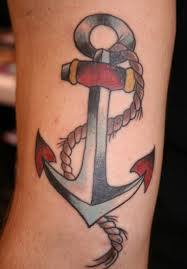
Here’s an idea for you: how about you go get a tattoo you don’t have to wait for . .
October 4, 2016
Lost (in) Bar Harbor
Hi. Barb here. I got to spend last weekend with many of your favorite Maine Crime Writers (plus Katherine Hall Page and Hank Phillippi Ryan) at Murder by the Book at the Jesup Memorial Library in Bar Harbor, Maine.
I was particularly happy to be invited this year because this summer I read Lost Bar Harbor by G. W. Helfrich and Gladys O’Neil. My fictional family, the Snowdens, are grappling with what to do with the deserted and now burned mansion on their island, so I have been vacuuming up information about Maine mansions and their architects.
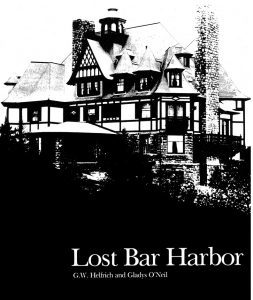 Bar Harbor makes a compelling case study. In the late nineteenth century, it was a resort not unlike Newport, Rhode Island. In the 1880s and 90s, 222 “cottages” were built for the elite of New York, Boston, Philadelphia, Washington and Chicago. They came in the summer and lived in a protected and unchanging cocoon that lasted until World War I.
Bar Harbor makes a compelling case study. In the late nineteenth century, it was a resort not unlike Newport, Rhode Island. In the 1880s and 90s, 222 “cottages” were built for the elite of New York, Boston, Philadelphia, Washington and Chicago. They came in the summer and lived in a protected and unchanging cocoon that lasted until World War I.
And then, almost as swiftly has it had started, it was over. In 1947, Mount Desert Island suffered a great fire. Two thousand people were evacuated in a caravan of 700 cars and buses, 400 more residents escaped by sea. (For a wonderful first hand account, see this article by Lance Tapley in Down East magazine.) Helfich and O’Neil write, “It is popularly believed that the Great Fire of 1947 finished off Bar Harbor as a resort. But the fire was for many a blessing in disguise. Although a third of the 222 cottages burned, many were already empty or for sale. Bar Harbor had tottered through the depression and World War II, and the summer of 1947 cottage directory reveals only 135 cottages were occupied that summer.” Indeed, Lost Bar Harbor is a catalog of change, “Demolished in 1938,” “Torn down in 1956,” “main section torn down in 1968, remaining are a wing added in 1928 and a library made into a cottage.”
I was determined to see some of this lost Bar Harbor, and for those purposes, the folks at the Jesup couldn’t have put us up at a better place. The Wonder View Inn is built on the foundations of Farview, later renamed Eaglesgate when it was purchased in 1937 by the writer Mary Roberts Rinehart, often called “America’s Agatha Christie.” Rinehart’s own cook tried to murder her there in the summer of 1947. The house burned in the Great Fire later that year, but you can still see its beautiful garden walls on the grounds of the Wonder View.

The garden steps at Farview, Mary Roberts Rinehart’s estate

Garden steps
Just up the street from Farview was Sonogee, the summer home of A. Atwater Kent, an entrepreneur who received his first patent at age ten. His enormous parties were legendary in Bar Harbor. Now without its second story, and with two wings added, Sonogee is a nursing home.

Sonogee
We found The Turrets still standing on the grounds of the College of the Atlantic. We were actually looking for a house called Guy’s Cliff, but never found it.

The Turrets
Eventually, we got tired of the game and gave up. We drove up Cadillac Mountain, and in keeping with the “Lost in Bar Harbor” theme, it was entirely shrouded in fog. But that was sort of fun by itself, and just means we have to go back someday.

Cadillac Mountain

Intrepid author emerges from the fog
Save
Save
Save
Save
Save
Save
Save
Save
October 3, 2016
Writers: Make audio one of the tools in the marketing chest
It’s no secret that authors these days have to be multi-taskers. No rest for the weary writer once the book is written.
Even the authors who have the best publishing deals have to be on social media, know how to market, make appearances. Those of us with smaller publishers have the same duties, only magnified in a lot of ways.
I’ve written here before about how every little thing we do as authors helps build the foundation for success. I never say no to an appearance request, make sure my social media accounts are active, visit libraries and book stores — you name it, I’ll do it.
I also wholeheartedly embraced the concept of audio versions of my books, though I don’t listen to audio books myself. I wrote here in July about how listening to the audio version of my first book, Cold Hard News, helped make me a better writer.
Now as the audio version of No News is Bad News, the second in the Bernie O’Dea series, nears the final production hurdle, I’m also grateful simply for one more way to bring my books to readers.
I am lucky that I own the audio rights to my books. I’m more than lucky that when I went on ACX.com to explore how to get an audio book made, I came across the perfect narrator and producer, exactly what I wanted. Trudi Knoedler lives in California and I live in Maine, but we certainly are right with each other on how my books should sound.
As with my last blog post on the topic, I won’t go into all the nuts and bolts. Dale Phillips’ blog post from 2013 explains it much better than I could.
The big benefit for me is that I’ve found that audio reaches readers that print and ebooks may not. I had a long conversation with a fan at an event last summer who was thrilled that Cold Hard News was on audio. It surprised me how fervent she was about it.
More recently, I got a nice note from Melanie Coombs, the librarian at MacArthur Library in Biddeford, saying how much she loved the audio of Cold Hard News and asking when No News is Bad News would be out. She enjoys listening to books and took the time out to listen to mine and then to let me know what she thought. She’s also letting patrons of her library know. She also took the time to compliment the job Trudi did with the narration.
A lot of what we do as writers is tough and there doesn’t always seem to be a lot of payoff. I’ve always said, and I sincerely believe, that every little thing adds to the whole. I decided to give audio a shot because — why not? — the books were written and Trudi would do all the work. But I’ve come to realize that it meant way more than that.
I’m looking forward to the audio version of No News is Bad News being available later this month. I put some of my rudimentary digital skills to work to make a little video of a sample to promote it. No, I know, that two-minute video won’t win any Oscars. But every little bit helps.
Check it out and let me know what you think. Click here to watch the video.
EVENTS: Maureen will be one of 10 authors reading from their works at Noir at the Bar, 3-5 p.m., Sunday, November 6, at Bull Feeney’s in Portland. Also reading will be Gayle Lynds, Gerry Boyle, Jen Blood, Barb Ross, Lea Wait, Bruce Coffin, Jessie Crocker, Brendan Rielly and Dick Cass. Kelly’s Books to Go will be selling books at the event by all of those who are reading. Come on over for a great afternoon!
Maureen Milliken is the author of the Bernie O’Dea mystery series. Follow her on Twitter at@mmilliken47 and like her Facebook page at Maureen Milliken mysteries. Sign up for email updates at maureenmilliken.com.
October 2, 2016
Books, You Say?
 Kaitlyn Dunnett, aka Kathy Lynn Emerson, aka Kate Emerson here to share a not-so-little problem that has been accumulating, so to speak, for quite a number of years.
Kaitlyn Dunnett, aka Kathy Lynn Emerson, aka Kate Emerson here to share a not-so-little problem that has been accumulating, so to speak, for quite a number of years.
Since 1984, fifty-four of the books I’ve written have been published under several names and by a variety of publishers. Some were paperback originals. Others came out in trade paperback only. Still others had hardcover editions and, in one case, only a hardcover edition. All of them but the first are available these days as e-books and that one, a non-fiction look at women of the sixteenth century, has been superseded by my online “A Who’s Who of Tudor Women.” Why am I telling you this? Because I’m writing today about a problem that is the direct result of having written too darned many books.
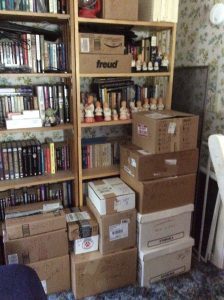
Writers receive author copies from publishers at about the same time their books hit stores. By and large, this is a good thing. Author copies are used to promote the book and as gifts and can be sold at signings when there is no bookstore available. But there is a down side. Although small presses generally provide only a handful of author copies, many publishers are extremely generous. Sometimes, for a variety of reasons, the author ends up with a whole lot of extra copies of a particular title.
 You’re probably thinking this still sounds like a good problem to have.
You’re probably thinking this still sounds like a good problem to have.
Not so much. Not if there are fifty-four separate and distinct titles involved and you wake up one day to realize that your house is overflowing with boxes of your own books. The most recently published titles? Those people want. But older books, what are called backlist titles, aren’t exactly in high demand.
I was writing for Bantam’s Loveswept line when it was discontinued back in 1998. Editors who were about to lose their jobs saw no point in handing out extra copies of those last titles to the folks who’d pulled the plug. Instead, they shipped extra cartons (48 paperbacks in each) to the authors. I still have 55 copies of Relative Strangers, 51 copies of Sight Unseen, 49 copies of That Special Smile, and 57 copies of Tried and True. The first three are set in the same world as the Liss MacCrimmon mysteries, where a few of the characters reappear, but they are, alas, not mysteries.
 There are other reasons why I’ve accumulated way too many copies of some books. When I wrote my Diana Spaulding 1888 Quartet of historical mysteries for a small press, sales didn’t go as well as anticipated. I had a choice between buying up extra copies at a discount or letting them be remaindered. I opted to buy, something I’d done before when I’d had a book about to go out of print. I hoped to be able to sell the books at signings, but here’s the sad truth—for the most part, when authors do appearances, most people who attend, if they buy books at all, are only interested in the new one or the first in the current series. Backlist titles, especially if they are in a different genre or set in a different era, gather dust.
There are other reasons why I’ve accumulated way too many copies of some books. When I wrote my Diana Spaulding 1888 Quartet of historical mysteries for a small press, sales didn’t go as well as anticipated. I had a choice between buying up extra copies at a discount or letting them be remaindered. I opted to buy, something I’d done before when I’d had a book about to go out of print. I hoped to be able to sell the books at signings, but here’s the sad truth—for the most part, when authors do appearances, most people who attend, if they buy books at all, are only interested in the new one or the first in the current series. Backlist titles, especially if they are in a different genre or set in a different era, gather dust.
Deadlier than the Pen is the first book in the Diana Spaulding 1888 Quartet, my “gothic” novel. She’s a newspaper reporter. He’s a horror writer from Bangor. What’s not to love? But I still have 60 copies in hardcover and 35 trade paperbacks in storage. The other three books in the quartet are Fatal as a Fallen Woman (56 copies in hardcover; 40 in trade paperback), No Mortal Reason (57 copies in trade paperback; there was no hardcover), and Lethal Legend (45 copies in trade paperback; there was no hardcover).

Something similar happened when, as Kate Emerson, I wrote six non-mystery historical novels that came out as trade paperback originals. My contracts called for me to get lots of copies. At the time I was not doing very much promotion and hardly any of that was appropriate for novels that weren’t mysteries. Readers I met wanted Kaitlyn’s books, not Kate’s, with the end result that my storage bins still contain 40 copies of At the King’s Pleasure, 43 copies of The King’s Damsel, and 54 copies of Royal Inheritance.
You may remember that I blogged last month about cleaning out the space under my bed. That’s the only place I have left to put new boxes of books. I just received a carton (48 paperbacks) of The Scottie Barked at Midnight (in stores as of September 27). Hardcovers of the third Mistress Jaffrey Mystery, Murder in a Cornish Alehouse, will be published in the UK on December 31 and copies will show up on by doorstep around the same time. Then there is the stack of hardcover Kilt at the Highland Games currently sitting on top of the file cabinet in my office. As fast as I sell, donate, or give away books, more turn up to fill the void. I’m under contract for five more mysteries in the course of the next two and a half years. Most will have more than one edition. There is no end in sight.
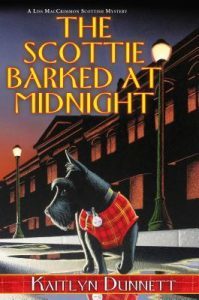
I can’t bear to throw books away, so don’t even suggest taking some of the older ones to the dump. The number of local institutions that will take donations of books is limited. Even libraries balk at being presented with too many, especially if the titles aren’t new. Experiments with Amazon Marketplace, Half.com, and eBay did not accomplish much beyond generating paperwork. I’m happy to shell out postage for a good cause, like the upcoming NHPTV auction, but even media mail rates would break the bank if I started shipping free books to everyone who asked for one. Library rate, sadly, only applies when one library ships books to another.
So, faithful readers, over to you. Can you think of ways to winnow down my book inventory? Any solutions that I can afford and that I haven’t already tried are welcome. In fact, in return for each viable option, I’ll reward the person who first suggests it in the comments section below with a free book. If you come up with something that might work, you can choose any title mentioned in this blog as your prize.

Kathy Lynn Emerson/Kaitlyn Dunnett is the author of over fifty books written under several names. She won the Agatha Award for best mystery nonfiction of 2008 for How to Write Killer Historical Mysteries and was an Agatha Award finalist in 2015 in the best mystery short story category for “The Blessing Witch.” Currently she writes the contemporary Liss MacCrimmon Mysteries (Kilt at the Highland Games) as Kaitlyn and the historical Mistress Jaffrey Mysteries (Murder in a Cornish Alehouse ~ UK in December 2016; US in April 2017) as Kathy. The latter series is a spin-off from her earlier “Face Down” series and is set in Elizabethan England. Her websites are www.KaitlynDunnett.com and www.KathyLynnEmerson.com
September 30, 2016
Weekend Update: October 1-2, 2016
 Next week at Maine Crime Writers there will be posts by Kaitlyn Dunnett/Kathy Lynn Emerson (Monday), Maureen Milliken (Tuesday), Barb Ross (Wednesday), Dick Cass (Thursday), and Lea Wait (Friday).
Next week at Maine Crime Writers there will be posts by Kaitlyn Dunnett/Kathy Lynn Emerson (Monday), Maureen Milliken (Tuesday), Barb Ross (Wednesday), Dick Cass (Thursday), and Lea Wait (Friday).
In the news department, here’s what’s happening with some of us who blog regularly at Maine Crime Writers:
Saturday, October 1, many of us (Kate Flora, Chris Holm, Lea Wait, Dorothy Cannell, Maureen Milliken, Barbara Ross, Bruce Coffin, Vaughn Hardacker + guest bloggers Gayle Lynds, Brendan Rielly, John Sheldon and Hank Phillippi Ryan will be speaking at Murder By the Book –a one-day mystery conference and celebration at the Jesup Memorial Library in Bar Harbor from 9:30 until 4:00. Open to the public — and free! Authors’ books will be available for purchase and signing.
Lea Wait: Friday, October 7, I’m looking forward to conducting a Professional Development Day for the teachers and staff at Harmony Elementary School in Harmony, Maine. Topic? The Joy of Writing: Exciting Our Students.
Kaitlyn Dunnett: The paperback reprint of last year’s hardcover, The Scottie Barked at Midnight, was released this past week. It’s also available as an ebook.


Kate Flora, still red-faced from missing her blog day yesterday, wanted to share the cover from Led Astray, her soon to be released Joe Burgess police procedural.
An invitation to readers of this blog: Do you have news relating to Maine, Crime, or Writing? We’d love to hear from you. Just comment below to share.
And a reminder: If your library, school, or organization is looking for a speaker, we are often available to talk about the writing process, research, where we get our ideas, and other mysteries of the business. Contact Kate Flora










